We arrived at the visitors center to find out that there would be a bus leaving for the Eisenhower farm in about an hour, so we bought tickets for that and toured the Soldiers National Cemetery in the meantime. In the heat of the moment, after the battle of Gettysburg was over but the wounded were still being attended to, no one had the time to properly bury the dead, and thousands of Union and Confederate soldiers were laid to rest in shallow graves. Starting in October, three months after the battle, the National Cemetery was begun, and 3,555 Union soldiers were reburied in proper graves. The bodies of Confederate soldiers were removed after the war and buried in southern cemeteries.
When we got out there, we noticed that there were actually two cemeteries side by side and found out that the Evergreen Cemetery next door was where Lincoln gave his famous address. It also contained a small memorial and American flag erected for Mary Virginia “Jennie” Wade, a 19-year-old woman who was the only known civilian gunshot death at Gettysburg:
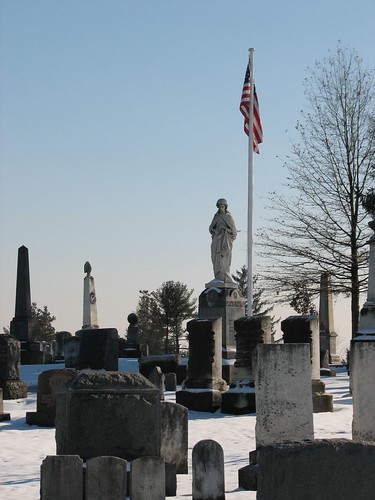
At the center of the National Cemetery sits a beautiful, massive memorial, the Soldiers’ National Monument. Its cornerstone was laid in 1865, and the monument was dedicated in 1869.
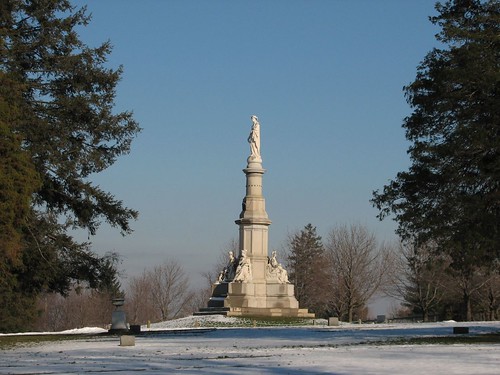

The statue at the top represents Liberty. The four statues situated around the base symbolize War, History, Peace, and Plenty.
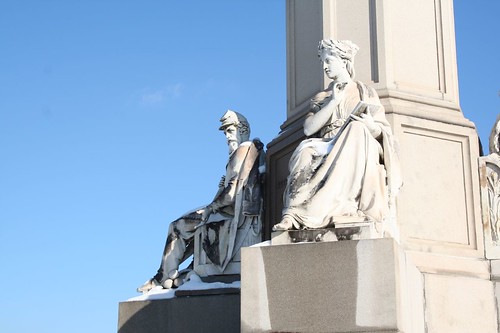
The soldiers’ headstones are small and simple, nearly flush with the ground. 979 soldiers were never identified and just received small numbered squares for headstones.
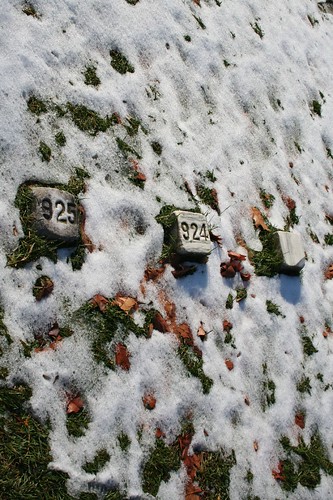
Since the Civil War, over 3,000 soldiers who died in other wars have also been buried in the cemetery, and many received engraved headstones.
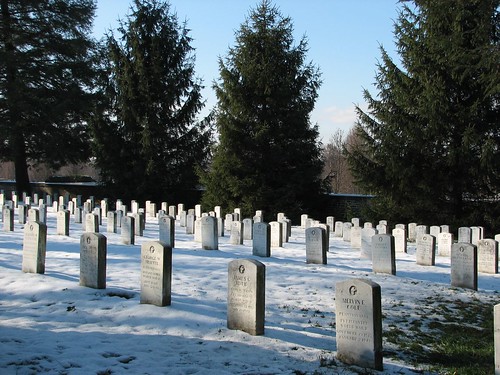
Now it was time to board the bus for Eisenhower’s farm. We learned that Dwight Eisenhower and his wife Mamie had spent most of their married life bouncing from place to place, living in over 35 different locations during his military and political career. In the early 1950’s, they bought this nearly 200-acre farm in Gettysburg as a place that they could call home and where they could retire.
The Eisenhowers decided to leave their farm to the National Park Service, with three stipulations. First, they could continue to live there for the rest of their lives. Second, no parking lot could be constructed on the property. Lastly, the land should continue to be farmed. That explained the bus we were on now – the Park Service runs periodic shuttle buses that take visitors the short distance from the visitors center to the Eisenhower property.
Here’s the Eisenhower house:

If you look carefully, you can see that the rightmost windows are smaller than the others. The Eisenhowers had bought the farm thinking that they’d be able to do some interior renovations of the farmhouse and preserve the exterior. After they bought the property, though, they realized that the brick exterior was just a façade over a rotting log frame, so preserving the structure wasn’t feasible. They did manage to preserve one section of the exterior façade, which is the rightmost section, and they rebuilt the rest of the house, matching the colors and style for the rest, but using larger windows.
Just a 35-minute helicopter flight from Washington, D.C., and a 10-minute helicopter flight from Camp David, the farm was host to many foreign dignitaries during Eisenhower’s presidency, and the success of Eisenhower’s famed diplomatic style was due in part to the atmosphere there. Touring the farm with Nikita Kruschev or chatting with Charles de Gaulle about the grandkids, who were often playing in the house, were great ways to break the ice before sometimes-heated policy discussions.
This room was the Eisenhowers’ porch and sitting room:
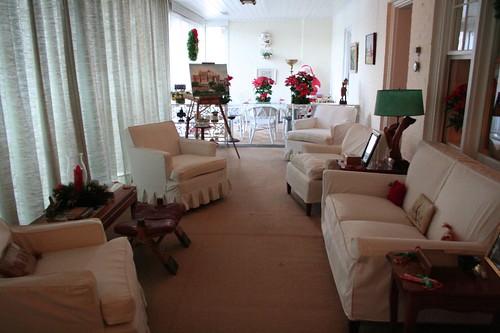
Today, the curtains are drawn to protect the interior of the house, which is virtually all original and as the Eisenhowers left it. But with the curtains open, this room got plenty of light through its floor-to-ceiling windows. The comfy, informal furniture made it a great place for the Eisenhowers to hang out and for Ike to meet with visitors. In retirement, Ike became quite a talented painter, and Mamie hung his paintings around the house. In the sitting room, you can see a painting on a canvas – that’s a replica of a painting that he was working on when he died in 1969. Mamie lived another 10 years, and the farm has been managed by the Park Service since then.
Here’s a room that’s night-and-day different from the sitting room:
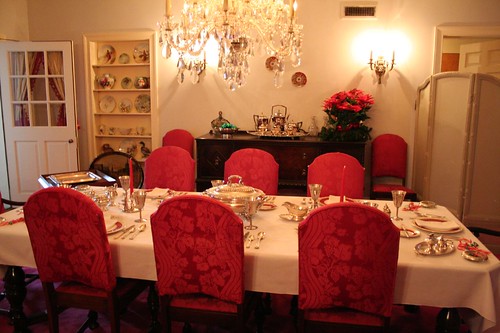
This is the formal dining room. The high, straight-backed chairs, the elaborate chandelier, the china shelves and extensive silverware place settings and serving containers – all combine to make for an impressive room, and one that the Eisenhowers didn’t use much, except for entertaining. A knowledgeable husband-and-wife volunteer team told us about the Eisenhowers and the property, and one point that they made clear was that the Eisenhowers weren’t much for stuffiness and formality.
During December, the house is all decorated for Christmas using the Eisenhowers’ decorations.
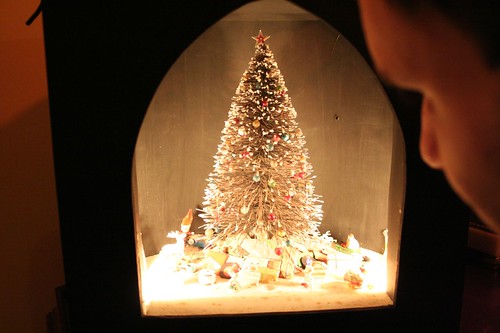
This is a snow-dusted Christmas tree with Christmas gifts, in a wood-and-glass case, lit from the inside. The gifts below the tree have the names of the Eisenhowers’ grandchildren on them. The volunteers didn’t know who had made this for the Eisenhowers, but given that the youngest grandchild’s name is missing, they date it to before that child was born.
Another interesting type of knickknack was presidential figurines. Apparently, miniatures of American Presidents and first ladies were given away in cereal boxes at one point in time, and Mamie collected them. So in a display case, along with the aforementioned Christmas tree and many other curios, you can see George and Martha Washington, Abe and Mary Todd Lincoln, and Dwight and Mamie Eisenhower, all in precisely detailed miniature.
After the Eisenhower tour, we returned to the visitors center. As we would learn later, the building will soon be demolished, so that the hallowed ground of the battle can return to its natural state. You hear the word “hallowed” a lot in Gettysburg, and it’s appropriate. The wide open fields contribute, where with a bit of imagination and some careful reading of the interpretive signs, you can picture in your mind’s eye the advances and retreats of the armies. But the hundreds and hundreds of monuments contribute as well, where you can picture veterans and loved ones of the dead returning to the scene of the battle to erect memorials to their brigades, their regiments, even their states’ soldiers, choosing to build something not only in remembrance of what happened at this place but the entire war.
You can buy a CD narration for a two-, three-, or four-hour tour of Gettysburg, and there are different driving routes to match. We only had a little over an hour before sunset, so we didn’t buy the CD and did our best to zip through the area. One of the first of the hundreds of monuments was a statue of Abner Doubleday.
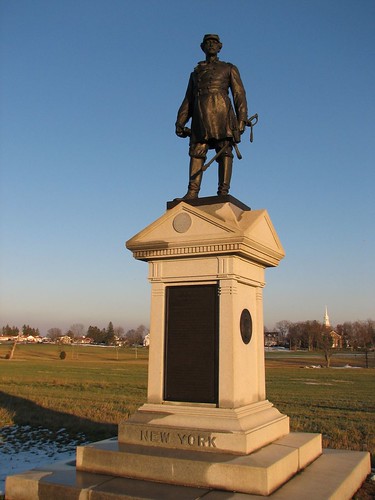
A colonel during the war and later promoted to major general, Doubleday is now most famously known as the inventor of the sport of baseball. The Baseball Hall of Fame is in Cooperstown, New York, because Doubleday supposedly invented the sport in a cow pasture in Cooperstown in 1839.
However, the main testimony linking Doubleday to baseball was provided by a guy who later shot and killed his wife and then wound up committed to an asylum for the criminally insane for the rest of his life. Those in charge of the sport clearly had an interest in linking its origins to a Civil War hero. And Doubleday himself never indicated a personal tie to baseball in his extensive writings. Historians now generally believe that baseball evolved from two earlier sports, cricket and rounders, rather than being invented in Cooperstown.
The late-afternoon light was pretty on the eternal flame and cannons:
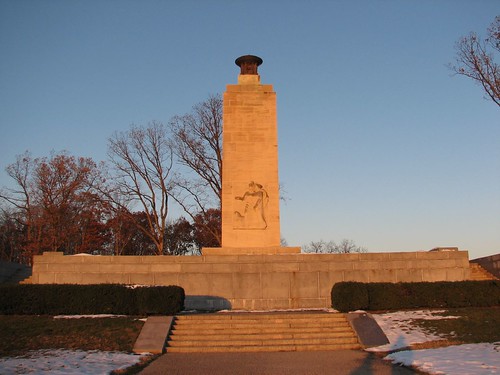

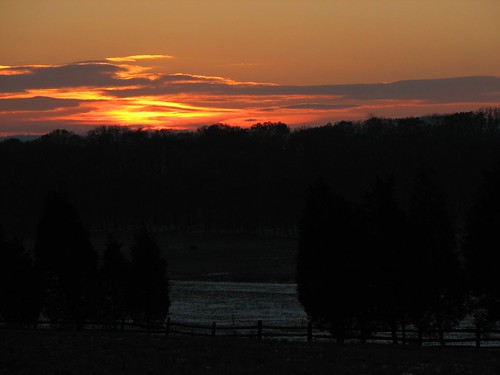
There are several towers around Gettysburg that were built for military purposes, and since then have been used for military training and as overlooks for visitors. One offered a great view of the Eisenhower farm.
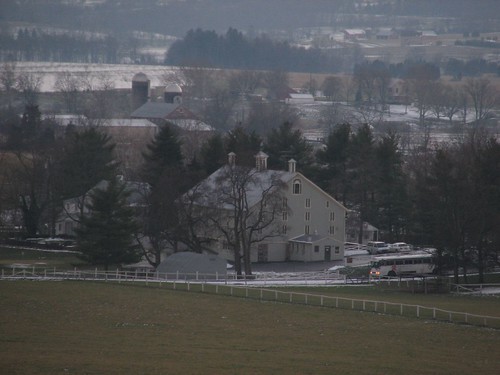
As the last light faded, we realized that although our quick afternoon tour of Gettysburg had been fascinating, there was still a lot more to see and learn. We still didn’t feel like we had a good understanding of how the battle had progressed, for instance, or even why it began. There were a couple of things working against us: First, the tour of the Gettysburg battlefield and monuments is designed for vehicles, so it’s a loop. When the Union and Confederacy were fighting, on the other hand, they weren’t concerned with auto tour convenience, so the battle moved around with no apparent order, sometimes flaring in multiple places at once. Due to this lack of foresight on the part of the generals and colonels in the war, the resulting vehicle tour is not in chronological order at all – you start the tour by learning about the first day of the three-day battle, but then the tour jumps to Day Three, then back to Day Two, and so on. The visitors center had a light show that showed the movements of the troops in chronological order over the battlefield – we didn’t see it, but in hindsight it might have been a useful initial overview to put the different sites on the tour into context.
Second, because of Gettysburg’s historical importance as the bloodiest battle and a key turning point in the war, hundreds of monuments and interpretive signs have been built, with precise detail about particular brigades and events, like this one:
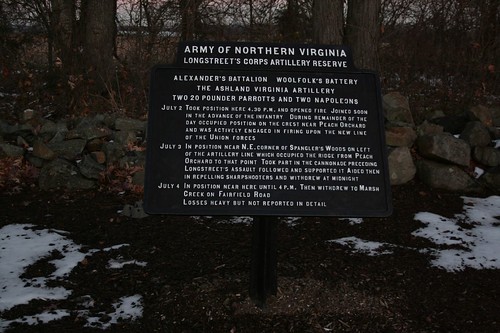
Trying to understand the battle from reading these signs on the auto loop tour, then, is like trying to understand American history by reading a stack of newspapers in random order. Reading more about Gettysburg later, we learned that General Lee’s Confederate army had crossed over the Mason-Dixon Line into Pennsylvania and was marching east toward Philadelphia when General Mead’s Union army encountered them by chance and engaged them on July 1, 1863, at Gettysburg. Reinforcements for both sides arrived in the next day, and at the peak, nearly 70,000 soldiers were fighting. By the end of the day on July 3, Pickett’s charge had failed, and the Confederate army was turned back.
After Gettysburg, we drove toward Lancaster County, which is the heart of Pennsylvania’s Amish country. We arrived at night but drove through the town of Lancaster anyway to see what we could see. The town itself, as it turned out, was disappointing – the business district looked like that of any poor town, with iron bars in the windows to prevent robberies of the dirty convenience stores.
Once we got out of town and onto a country road, we noticed a slow-moving vehicle ahead, with its hazard lights on. Even though the road had a solid double line down the middle, the car ahead of us passed the slow vehicle, so we did, too. As we passed, we realized that it wasn’t a car or truck but a carriage, pulled by a trotting horse! We passed three or four other horse-drawn carriages before arriving at our bed and breakfast. Although the Amish are generally against mechanization and electricity, the state requires them to run their carriages with hazard lights on for their own safety.
The Verdant View Farm Bed and Breakfast was our destination for the night.
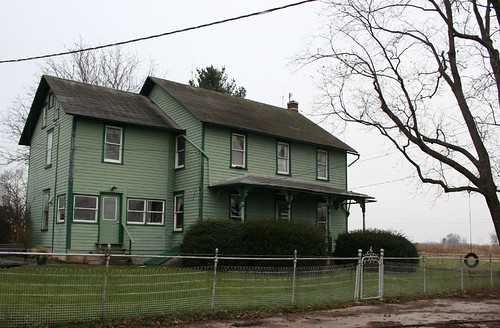
We sat up for a while chatting with the couple who owned the place, Ginnie and Don, before heading to bed. The man was excited to pop some corn for us – they actually grow popcorn corn and pop it right on the cob! Some trial-and-error had been required, though, to figure out the process of popping corn on the cob. They first butter the cob and put it in a paper bag. But popped just like that, the microwave overheats and shorts out – they shorted two microwaves this way. Then they hit upon the idea of putting a mug of cold water with ice into the microwave, next to the bag of popcorn. The water absorbs some of the microwave’s energy and prevents it from shorting out, and you get not only a bag of popcorn but also a cup of hot water for tea! We ate tasty popcorn and drank tea to go along with the dinner that we cooked for ourselves.
The bed and breakfast is actually a working farm, so the next morning we got up at 6:30 a.m. to help out with the farm chores. As it turned out, “helping out” mostly meant watching the woman who runs the place and one of the farmhands, but it was a lot of fun. When we got out to the barn, Ginnie apologized for not having offered us fresh milk the night before. One of the farmhands hadn’t claimed his morning coffee yet, so she gave it to us. The “coffee” was really mostly fresh cows milk with a splash of coffee added in. Ginnie deemed it to be too cold, so she “warmed it up” with a few squirts of milk directly from the cow!
They showed us how to milk a cow by hand, and we both tried our hand at it, grabbing one teat near the top and squeezing it all the way down, and marveling at the milk squirting out as a result. It was pretty clear that even if we got good at milking and could do it quickly, hand milking would take way too long with 45 milk cows needing to be milked twice a day. So it wasn’t surprising that they had machinery that could milk six cows at a time – even so, it still took a long time for all 45 cows to progress through the milking process.
Some of the milk was set aside and loaded into half-gallon baby bottles – this was for the three calves. Along with the farmhand, we each got to feed a calf out of a baby bottle – just tip the bottle up and a minute or two of non-stop sucking later, it’s dry. Then load it up again and feed the calf again – each calf gets two bottles in the morning and two in the evening, for a total of two gallons of milk a day!
Here are the little guys, full and happy, taking their after-breakfast nap:
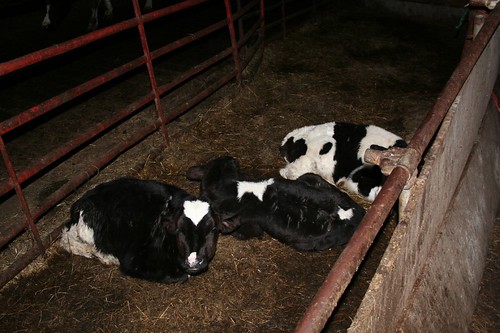
Although the farm is a working farm, it’s managed in part as an attraction for the tourists who stay at the bed and breakfast, so there are a variety of other farm animals. We got to feed corn to a donkey:

We also were supposed to feed the goat, and when we got outside, the goat walked right up to us – it had broken its chain free! Brian grabbed it by the chain and walked it around the back of the farm, trying to figure out where to tether it. The goat wasn’t very big, but boy, was it strong, and stubborn, too! When it dug in its feet, it took all of Brian’s strength to get it moving again. Eventually we found the spool that acts as its goat house and got it reattached. It was rainy and chilly, so the goat went inside and peeked out:

The bed and breakfast was a lot of fun. Sarah had been around farms growing up, but Brian hadn’t, so seeing the milking operation and feeding the calves were novel activities. And we had the place pretty much to ourselves – a mother and daughter were the only two other people staying there on a Saturday night in December.
After we left the B&B, we drove east, taking a scenic drive through rolling hills and farms. It was a cool, rainy Sunday, so there wasn’t much activity outside, but we did see a couple more horse-drawn carriages. The carriages are pretty nice – they’re entirely enclosed, keeping the passengers sheltered from the elements.
Around midday, we arrived at Valley Forge, just west of Philadelphia and our destination for the afternoon. This is where George Washington’s Revolutionary War army spent the winter of 1777-1778. Given that the Revolutionary War lasted eight winters, though, and we hadn’t heard of any of the other winter camps, it wasn’t initially clear to us why Valley Forge has become so well-known. The winter at Valley Forge was harsh, but a later winter during the war was even harsher. Supplies were tight, but people generally had enough to eat. Nearly 2,000 soldiers did die, though, most of those during the months of March through May, when the weather was warmer and supplies more abundant, indicating that most of the deaths were due to disease rather than cold or starvation.
What made Valley Forge so important, we decided, was that it became a symbol. 1777 was pretty early in the war, when the outlook for defeating the British seemed bleak – the colonial troops were a ragtag bunch, without much discipline or organization. They were undersupplied and didn’t have the support they needed from the Continental Congress, so Washington wrote a series of eloquent letters, explaining (and sometimes exaggerating) the hardships faced by the troops to get better support.
And the victory over the British truly was an amazing achievement – a ragtag bunch of colonists ultimately defeated one of the greatest militaries in the world. As historians wrote the early history of the country, it was natural that they would latch onto symbols to stir the patriotism of the citizens of the young country, and Valley Forge became the symbol of the hardships and suffering faced by the colonial army in their quest for independence.
In addition to learning about the historical importance of the site, we also got to goof around in the visitors center. Here’s Sarah as a colonial solder:

After leaving the visitors center, we embarked on a five-mile driving tour of the park. This tour was easier to understand than the Gettysburg tour, since there was no out-of-order battle action to piece together.
At one of the first stops, we encountered some very small British soldiers. They had arrived just a couple centuries too late to attack the colonial army, but they were running around just the same:
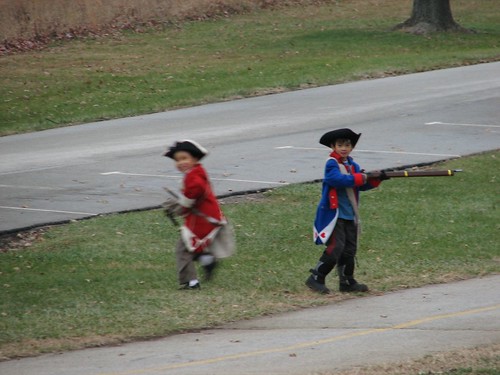
We got them to stand still just long enough to take a picture:
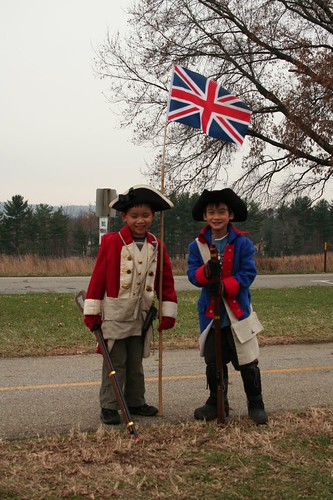
The National Memorial Arch is the main monument in the park, dedicated in 1917 to the soldiers’ “patience and fidelity”:

General Anthony Wayne commanded the Pennsylvania troops. This statue sits in the area where they camped, and Wayne faces toward his home nearby. Sarah jumped in the picture to show the magnitude of the statue:

Valley Forge is so named because of an iron forge that was built along Valley Creek in the 1740s. The owners of the forge reluctantly allowed the colonial army to turn it into a supply base, with assurances that it would be safe from the British. Nevertheless, the British came through in the summer of 1777, stole what they could from the forge and nearby mills, and torched the rest. The forge owners, along with some colonial troops, tried to turn back the British, but to no avail, and the owner of the forge was financially wiped out.
Some of the homes at the forge site were spared, however, and when Washington selected Valley Forge as the site for the winter encampment, he turned the Isaac Potts house into his headquarters:
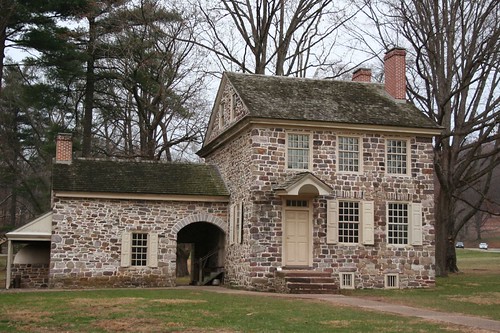
We toured the inside of the house, which is furnished with period pieces and replicas to look like it may have looked when it was the headquarters.
Valley Forge’s historical significance is mostly symbolic, but one thing did happen there to impact the outcome of the war: The troops were trained and turned into a more professional army. The former Prussian officer Baron von Steuben arrived in February and delivered a hands-on training program, first focusing on training Washington’s personal guard forces, and then using them to help train the rest of the troops. Here’s a statue of von Steuben:

Southern Pennsylvania, and in particular the protected areas of Gettysburg and Valley Forge, is home to a lot of deer. This one posed for us near the end of our tour:

After we left Valley Forge, we drove a mile to what our guidebook called the largest retail shopping mall in the U.S., King of Prussia Mall, just to take in the spectacle. We thought the largest was the Mall of America in Minneapolis, but whatever – King of Prussia was huge. The merry-go-round at the center of the mall was painted with Valley Forge scenes like the National Memorial Arch, and Santa was meeting a long line of kids and posing for pictures at the base of the merry-go-round:
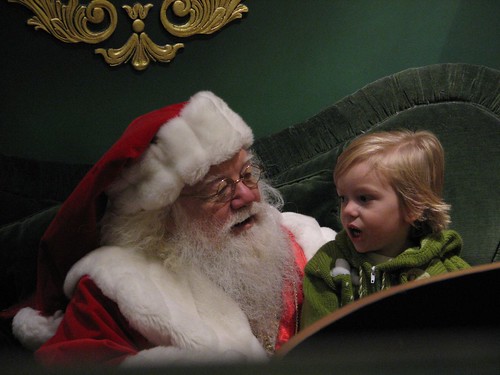
After walking through the rest of the mall, foraging for free chocolate samples and buying a few postcards, we set out for New York City, where we’d be spending the next two nights in a friend’s Manhattan apartment!
No comments:
Post a Comment